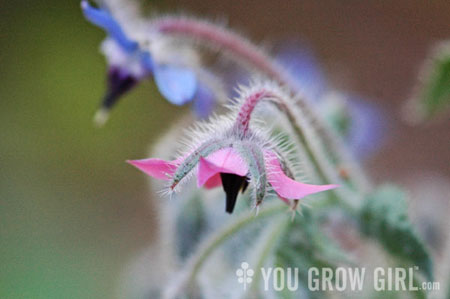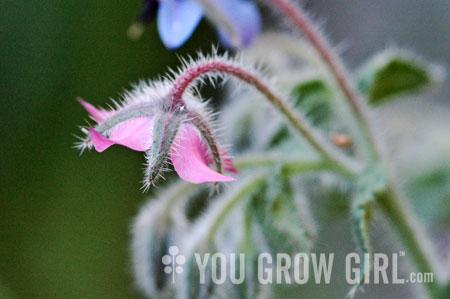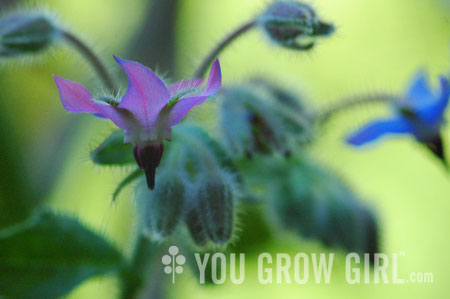
I’ve never been able to determine why borage (Borago officinalis) flowers, which are typically blue, sometimes turn pink. Some books mention the possibility of pink and even white flowers but don’t account for why they appear.
I don’t think it is related to soil pH as is the case with some flowers.
Could it be fertility? I’ve been amending and improving on the soil at my community garden for years and am noticing more borage flowers this year than ever before.
This leads to the possibility of weather as a factor since it’s been unseasonably cool and rainy around here. But then again, it was awfully rainy last year and I don’t remember spotting any pink flowers at m plot.

Borage has been self-seeding in my community garden plot for as long as I’ve had it, most likely inherited from Peter, the gardener that came before me. Plenty of little seedlings come up around the plot but I don’t find it to be as aggressive as dill, feverfew, or artemisia. Do not get me started on the invasive nature plant! We’ve been locking horns for years and the artemisia always comes out on top.
Every year I let most of the plants grow to a certain size before I start culling. Borage tends to fair better in poor soils. The borage at my community plot have grown taller and lankier as I’ve improved the fertility of the soil. I let the stockiest plants with the thickest stems stay put as long as they’re not in a spot predestined for something more important like a tomato, zucchini, or pepper. Some plants have grown to be taller than me with stems as thick as 2″ or more!

I add the flowers to salads and drinks, and sometimes eat the very young, most tender leaves raw. Many books suggest adding the chopped leaves, which have a slight cucumber flavor, to cream cheese but I have never tried this.
The best recipe I have been able to come up with for the pricklier leaves and stems are fritters. To make them simply make up a batter, add chopped onion and borage leaves and fry spoon-sized dollops in hot canola oil. You can quickly blanch the leaves and stems if they seem too hard.
Borage is also an anti-inflammatory that is sometimes used in beauty products such as creams and toners to treat skin conditions.
Purty flowers. I’m growing borage for the first time this year at my community garden. Got it for the blue flowers. Interesting to see what colours I get this year.
I realized the other day that I am missing borage in my garden this year. It usually shows up somewhere! Yours are so pretty.
Gayla, I know there are certain penstemons here in CO that change color from purpleish to pink once they’ve been pollinated. The color becomes an indicator to the insect population and pollinators at large. I have no idea what the story with Borage is, but I thought I’d throw that out there as food for thought.
Wow, those are gorgeous blossom colors! I’ve never tried borage, but will now. thanks for the tip :-)
I know that hydrangea colors can change according to the ph & aluminum content of the soil:
http://www.hydrangeashydrangeas.com/colorchange.html
maybe something similar is at work with borage?
oops. just saw that you eliminated ph as a factor already. sorry.
Borage flowers turn from blue to pink as they age. They make a great tea to alleviate anxiety, and also improve the flavor and growth of tomatoes. Bees love the flowers.
Ciao Gayla-
I knew that the leaves were edible, but their furriness has sort of put me off. Some articles on the net suggest that borage leaves can be used in place of spinach and that the act of cooking them takes away the fur. I’ll try it and report back. ;o)
I think I’d have to agree with Karen from Vermont based on my own small borage experience. They’re growing in with my strawberries and self seeded after being purposely sewn last year. I still get surpised when I see the pink flowers, but I like the added variety.
I don’t think it’s a pollination thing. The blue ones form seeds. Maybe if they go to a certain age without being pollinated… I don’t know if I’ve seen the pink ones with seeds in ’em.
In botany you kind of learn to ignore flowers. To an extent they can be used for picking up on a species, genus etc but for the most part the physical characteristics can be so finicky due to even slight changes in environmental factors that often it doesn’t mean anything.
Case in point, I swore up and down to my mentor that I was seeing a new species of whorled coreopsis, but upon further investigation the flower I was seeing was indeed the same species with environmental differences affecting the pedals of the flower wildly… and I was out 5 bucks.
It’s not just about aging or pollination. I have read about this theory but should add that I don’t see this on all of my plants. Only some plants within the same garden make pink flowers. Some pollinated flowers stay blue.
Some aging flowers stay blue.
I am leaning more towards environmental differences as Sunny Hart posited.
I planted borage this year for the first time and love the look of it. I got some to attract beneficial insects. I read tests have shown that per square foot, borage has the largest population of beneficials. I planted basil near tomatoes this year to ward off the horned worms and that worked, will try all the new uses for borage next year.